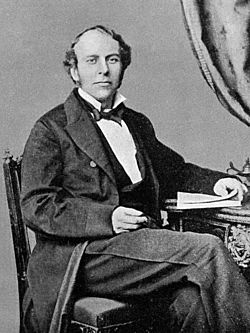Joseph Toynbee facts for kids
Quick facts for kids
Joseph Toynbee
|
|
|---|---|

Joseph Toynbee, published in 1910
|
|
| Born | 30 December 1815 Heckington, Lincolnshire, England
|
| Died | 7 July 1866 (aged 50) |
| Known for | pathological and anatomical studies of the ear |
| Children |
|
| Scientific career | |
| Fields | Otologist |
Joseph Toynbee (born December 30, 1815 – died July 7, 1866) was an important English doctor. He was an Otologist, which means he specialized in studying the ear. His entire career was focused on understanding ear diseases and the ear's structure. He made big discoveries about how our ears work.
Joseph Toynbee's Early Life and Family
Joseph Toynbee was born in Heckington, England. This was on December 30, 1815. He was the third of fifteen children. His father, George Toynbee, was a wealthy farmer.
Joseph had private lessons for several years. Then he went to King's Lynn Grammar School. At age seventeen, he began studying medicine. He learned about medicine by working with William Wade in London. He also studied how the body is built at the Hunterian Medical School. He became very good at preparing bodies for study.
Joseph married Harriet Holmes on August 4, 1846. They had nine children together. Their children included Arnold Toynbee, who became an economic historian. Another child was Grace Frankland, who became a bacteriologist.
Joseph Toynbee died on July 7, 1866. He was doing experiments to find a cure for ringing in the ears, called tinnitus. He was buried in Wimbledon, England.
Joseph Toynbee's Medical Career
Joseph Toynbee did many studies on the ear. He looked at how the Eustachian tube works. This tube connects your middle ear to your throat. He also studied the tympanic membrane, which is your eardrum. He even tried to repair eardrums, a surgery called tympanoplasty.
When St. Mary's Hospital opened, he became an ear surgeon. He also taught classes about ear diseases. His lectures were published in books. He wrote two important books about the ear. One was "A Descriptive Catalogue of Preparations Illustrative of the Diseases of the Ear" (1857). The other was "The Diseases of the Ear: Their Nature, Diagnosis and Treatment" (1860). He studied many "deaf ears" to learn about a condition called ankylosis of the stapes. This is when a small bone in the ear gets stuck.
In March 1842, he became a Fellow of the Royal Society. This is a very important group for scientists. Another ear doctor, Adam Politzer, wrote about Joseph Toynbee. Politzer thought Toynbee was a big influence on his own work.
Joseph Toynbee's Published Works
Joseph Toynbee wrote several important books and papers. These helped other doctors learn about the ear.
- On the structure of the membrana tympani in the human ear. (1851)
- On the use of an artificial membrana tympani in cases of deafness : dependent upon perforation or destruction of the natural organ. (1857)
- A Descriptive Catalogue of Preparations illustrative of the Diseases of the Ear in the Museum of Joseph Toynbee. (1857)
- The Diseases of the Ear: Their Nature, Diagnosis, and Treatment. (1860)
- Hints on the Formation of Local Museums. (1863)


